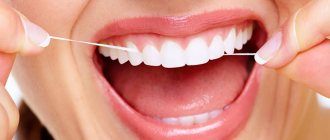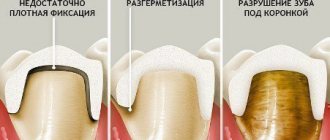Causes of bad breath
Halitosis occurs when the exhaled air contains volatile compounds with an unpleasant odor. Their sources can be 1,2,3,4,6:
- some food products (garlic, onions, cabbage);
- products of carbohydrate fermentation (fermentation);
- decaying food debris;
- waste products of bacteria.
However, the main cause of bad breath is the production of hydrogen sulfide by anaerobic bacteria in the mouth. Their peculiarity is their ability to live without oxygen and in places that are difficult to reach with a toothbrush, for example, on the back surface of the tongue and the back wall of the pharynx, between the teeth, in gum pockets, on the tonsils, in the natural grooves of the teeth1,2,3.
to come back to the beginning
Risk factors
Factors that promote the growth of oral bacteria can cause halitosis. They are conventionally divided into local and general1.
In 80-90% of cases, halitosis is found to be caused by one of the following reasons1,2,3,4,6:
- caries and its complications;
- inflammation in the periodontium;
- diseases of the oral mucosa;
- poor hygiene, especially poor cleaning of teeth, tongue, orthopedic and orthodontic devices (prostheses or braces) - neglect of oral care leads to the accumulation of food debris, which is food for microbes, between the teeth, near the gums, on the back of the tongue, on the elements of the device ;
- deficiency of saliva with xerostomia or “dry mouth syndrome” - with a decrease in salivation, the natural cleansing of the oral cavity is disrupted and favorable conditions are created for the proliferation of microbes.
If local causes of halitosis are associated with the oral cavity, then general ones are associated with the condition of the whole organism1,2. But indirectly, general factors can influence oral health by promoting mucosal dryness and bacterial growth1,2.
Thus, the following factors can contribute to the proliferation of bacteria and the appearance of bad breath:
- Nutritional features. Eating large amounts of protein (meat, fish), coffee, carbonated drinks (sweetened with sweeteners) and alcohol promotes the growth of bacteria that produce “fragrant” volatile compounds1,2,3.
- Smoking. Although nicotine and tobacco combustion products have an unpleasant odor, this is not the only cause of halitosis in smokers. Due to smoking, the oral mucosa becomes dry, the number of bacteria on it increases, and inflammatory processes in the periodontium may occur1,2,3. All this contributes to the appearance of bad breath.
- Hormonal changes. Women may experience bad breath during menstruation. “Menstrual breathing” occurs due to fluctuations in the level of hormones that affect the properties of saliva, making it more viscous2. In addition, stress hormones can influence the growth of oral bacteria that produce volatile compounds2.
- Some medications , such as antibiotics and hormones (glucocorticosteroids), reduce saliva production, which promotes the growth of anaerobic bacteria3.
to come back to the beginning
Formation of gases in the intestines
The predominant microflora in the intestines “feeds” mainly on dietary fiber and incompletely digested carbohydrate residues - oligo- and disaccharides. Some carbohydrates and hard-to-digest fibers are not fully digested in the small intestine; from there they enter the large intestine and are used by microflora2,4.
Microbial fermentation processes are accompanied by the release of large amounts of gases. As a result of lactic acid fermentation, lactic acid, carbon dioxide, hydrogen, water and other substances are formed. Alcoholic fermentation leads to the appearance of carbon dioxide and ethanol, formic acid, propionic acid, butyric acid and other types lead to the release of volatile fatty acids, carbon dioxide, hydrogen and water. In addition, carbon dioxide is produced as a result of chemical alkalization of the acidic contents of the stomach in the duodenum4.
Methane is released during the vital activity of colon microflora and depends little on the composition of food, and hydrogen sulfide is released during the breakdown of sulfur-containing amino acids by microflora4.
If some processes accompanied by the release of gases are too active, and the removal of gases through the lower gastrointestinal tract is difficult, flatulence develops.
Types of flatulence depending on the cause of its development1,4
- Nutritional.
- Digestive.
- Dysbiotic.
- Dynamic.
- Mechanical.
- Circulatory.
- High-rise
- Psychogenic.
The syndrome of increased gas formation is closely associated with alimentary, digestive, dysbiotic and dynamic types of flatulence.
| Alimentary flatulence | mainly caused by aerophagia, that is, swallowing air, for example, during a rushed meal or conversation at the table, as well as by eating foods whose digestion is accompanied by increased gas formation1: fiber-rich vegetables and fruits, beans, peas, black bread, kvass, beer and others2 |
| Digestive flatulence (the name comes from “digestion” - digestion) | caused by disruption of food digestion1. Disturbances can occur due to an absolute or relative lack of digestive enzymes, in particular due to disruption of the pancreas, lactose and gluten intolerance, impaired bile acid metabolism and even overeating1,2 |
| Dysbiotic flatulence | develops due to a disturbance in the composition of the intestinal microflora and can accompany a variety of gastrointestinal diseases1 |
| Dynamic flatulence | occurs when there is a violation of intestinal motility, for example, with irritable bowel syndrome (IBS). Accelerated or slow movement of food through the intestines leads to disruption of digestion processes and changes in intestinal microflora. Therefore, dynamic flatulence is closely related to digestive and dysbiotic1,2 |
Up to contents
How does halitosis manifest?
Constant bad breath is one of the symptoms of periodontal disease2. With physiological halitosis, when there are no dental or general diseases, the unpleasant odor is a temporary phenomenon. It appears after eating specific foods (onions, garlic) and disappears some time after eating and brushing teeth6. If you notice bad breath in the morning or after intense physical activity, it is likely that you are not producing enough saliva or it is drying up quickly due to breathing through your mouth at night or during exercise6.
to come back to the beginning
Symptoms of flatulence
Gaseous substances in the intestines are contained in a free and bound state. Free gases, thanks to intestinal peristalsis, constantly move towards the lower gastrointestinal tract and are excreted in portions: approximately 40 ml 15-20 times a day1,2.
Bound gases are enclosed in small bubbles lined with mucus4. With flatulence, their number increases sharply and foam forms. The increasing volume of foam leads to stretching of the intestinal wall. This causes discomfort in the abdomen, sensations of bloating, fullness and rumbling, as well as the development of pain. Additionally, abdominal enlargement and flatulence may be observed - frequent and profuse passage of gases, often with a foul odor and sound of varying timbre and volume1.
Symptoms of flatulence
- Regurgitation.
- Belching air.
- Feelings of bloating and fullness in the abdomen.
- Increase in abdominal circumference.
- Rumbling in the intestines.
- Stomach ache.
- The release of large amounts of gases from the intestines (flatulence)1.
The appearance of abdominal pain during flatulence is associated with overstretching of the intestinal walls and its mesentery. The degree of discomfort depends on the height of the pain sensitivity threshold: the lower this threshold, the more severe the pain. It appears in one part of the abdomen, gradually intensifies, then, as the gas bubble moves through the intestines, it weakens and even disappears, but then appears again, albeit in a different place in the abdominal cavity1.
Foamed stool covers the intestinal walls and makes it difficult to digest food and absorb nutrients1. This further complicates the situation: undigested food remains accumulate in the intestines and fermentation processes intensify. Gas formation increases, the symptoms of flatulence become even more pronounced.
If it persists for a long time, flatulence can disrupt a person’s usual way of life, force him to give up active pastime and limit communication. This can lead to psychological problems, increased anxiety and depression2.
Up to contents
Treatment
Often a person tries to get rid of bad breath on his own - using refreshing sprays or chewing gum. But this approach does not eliminate the causes and acts temporarily - complete disappearance of the unpleasant odor can only be achieved under the supervision of a doctor, who will determine the causes and select individual treatment2,5.
If halitosis is confirmed by tests performed by a doctor, it is considered true. But sometimes a person is sure that his breath is bad, although those around him do not smell anything. Doctors refer to this condition as false halitosis or pseudohalitosis1,3.
As a rule, people with bad breath should first consult a dentist1. For physiological halitosis, proper oral care is taught, including brushing the teeth and tongue1,4,6. If the problem of bad breath lies in dental diseases, then the doctor1.6:
— carries out professional hygiene — removes dental plaque;
- eliminates foci of infection - treats or removes decayed teeth, cleans periodontal pockets;
— prescribes therapy aimed at restoring saliva deficiency;
— in case of inflammatory processes, prescribes drug treatment.
to come back to the beginning
Surveys
A gastroenterologist examines patients with complaints of putrefactive erection. Since rotten belching most often indicates the presence of a pathological condition, the diagnostic search is aimed at identifying the root cause of the symptom. The patient undergoes a comprehensive examination to study the morphological and functional features of the digestive and biliary system. The most valuable methods are:
- Sonography
. Ultrasound of the abdominal organs is an accessible non-invasive examination that is prescribed for rapid diagnosis. The method is not accompanied by radiation exposure and makes it possible to detect nonspecific signs of inflammatory diseases and space-occupying formations. According to indications, targeted ultrasound examination of individual organs is performed. - Endoscopy
. Endoscopy is used in the diagnosis of pathology of the upper gastrointestinal tract to identify motility disorders, dysregulation of the pyloric sphincter, and signs of hypoacid conditions. For colonic symptoms, colonoscopy is informative, allowing, if necessary, a biopsy of the affected areas. Video capsule endoscopy is used less frequently. - X-ray methods
. X-ray with oral contrast is used to visualize all parts of the gastrointestinal tract; taking delayed images allows you to assess the speed of passage of contents through the intestines and the coherence of the muscle sphincters. To study the biliary and pancreatic ducts, RPCP and percutaneous cholangiopancreatography are prescribed. - Stool analysis
. Diseases accompanied by rotten erection often cause pathological changes in the feces. The standard coprogram can be supplemented by tests for helminth eggs and an expanded bacteriological study. If neoplasms or ulcerative-destructive processes are suspected, the Gregersen test for occult blood is performed.
Laboratory methods are recommended to clarify the diagnosis; patients may be prescribed liver tests, determination of the levels of pancreatic enzymes in the blood and urine, and measurement of the concentration of gastrin and pepsinogen in the blood. To assess gastric secretion, 24-hour pH measurements are performed.
A patient with complaints of rotten belching undergoes a comprehensive gastroenterological examination
Metrogyl Denta® for inflammatory diseases of the oral cavity accompanied by halitosis
Since one of the causes of bad breath is inflammatory periodontal diseases2, one of the directions of therapy should be the treatment of inflammatory diseases of the oral cavity.
Dental gel Metrogyl Denta® is a drug that can be used for the treatment and prevention of most infectious and inflammatory diseases of the oral cavity, in particular gingivitis and periodontitis7. It contains two active antimicrobial components - the antibiotic metronidazole and the antiseptic chlorhexidine, which are effective against the main anaerobic bacteria that cause periodontal diseases7.
to come back to the beginning
Prevention methods
To avoid the occurrence of halitosis, it is recommended6:
- Reduce the amount of dental plaque. It is important to promptly clean teeth, dorsum of tongue, dentures and braces from bacteria and accumulated food. To do this, you need to use not only a toothbrush, but also dental floss, brushes and mouthwash.
- Balance your diet - limit your intake of carbohydrates (sweets), which oral bacteria use as nutrients.
- Fight bad habits - limit the number of cigarettes you smoke or give up smoking completely, drink less coffee and alcoholic beverages.
- Increase your fluid intake - this makes saliva production easier.
Bad breath should not lead to problems in communication, especially since it is not difficult to deal with. Professional teeth cleaning, treatment of periodontal diseases and careful personal oral hygiene help get rid of halitosis in 80.7% of patients. Therefore, the right decision would be to make an appointment with the dentist as soon as you notice bad breath. If symptoms persist after eliminating dental causes, you should seek help from a therapist1,5,6.
general characteristics
Olfactory hallucinations vary in content.
Unpleasant imaginary odors are associated primarily with a depressive mood, including anxiety, fear, and suspicion. Patients smell rot, decomposition, toxic substances, and sewage. To ease the sensation, they cover their nose with their hand, insert cotton swabs into the nasal passages, ventilate the room for no objective reason, and use air fresheners. Such hallucinations often serve as the basis for the formation of delusional ideas, for example, about the use of poisons by attackers or the storage of corpses. Olfactory hallucinations of pleasant content are represented by the aromas of flowers, delicious food, and favorite perfumes. Often, patients cannot guess what the source of the smell is; they describe it as unearthly, giving joy, inspiring. Hallucinatory experiences accompany ecstatic, manic states. Imaginary perceptions of odors of a neutral nature are usually not noticed by people and are not grounds for complaints.
Olfactory hallucinations vary in where sufferers identify their source. It can be localized in the environment (on the street, in the next room), in the patient’s body or in imaginary space (in the air, “in the soul” - in mental space). As a rule, the unpleasant smell of poison, rot, or sewage is defined as emanating from external objects; the smell of sweat, urine, decomposition of organs - from one’s own body. The imaginary causes of pleasant odors are magical, mystical sources that are not present in the physical world.
Bibliography
- Khitrov V. Yu., Zabolotny A. I. Halitosis - a medical and social problem // Practical medicine. - 2009. - No. 1 (33). — P. 12-17
- Gorobets S. M. et al. Risk factors for the development of halitosis (review) // Crimean Therapeutic Journal. — 2022. — No. 3. — P. 13-18
- Maksimova E.V., Stetsyuk N.S., Shelikhova E.O. Halitosis as a medical and social problem // Crimean Therapeutic Journal. — 2020. — No. 1. — P. 32-37
- Temkin E. S., Churikova A. S. Halitosis - modern diagnostic methods and their prospects // Volgograd Medical Scientific Journal. — 2022. — No. 3. — P. 15-18
- Vinogradova T. G. Bad breath - halitosis, causes and treatment options // Bulletin of VSMU. - 2014. - T. 13. - No. 2. - P. 129-131
- Ushakov R.V. et al. Modern methods of diagnosis, elimination and prevention of halitosis // Textbook: Moscow. - 2016. - 81 p.
- Instructions for the medical use of the drug Metrogyl Denta® Dental gel // Registration number P N015982/01 // State Register of the Russian Federation. – URL: https://grls.rosminzdrav.ru/Grls_View_v2.aspx?routingGuid=9bc9a05c-d28b-473d-b8d4-60e8b8323762&t=
Modern aspects of the prevention of diseases of the oral mucosa in patients with xerostomia / L.D. Weisheim, L.M. Gavrikova, T.N. Gomenyuk, T.V. Motorkina, L.N. Shcherbakov, S.M. Dubacheva, G.V. Sorokoumova//Medicinal Bulletin.—2013.—No. 2 (50). -WITH. 32-37.








